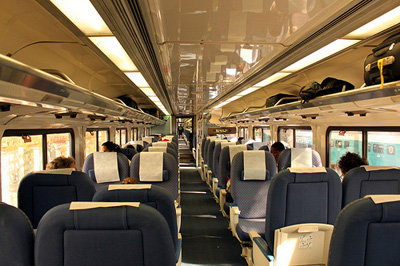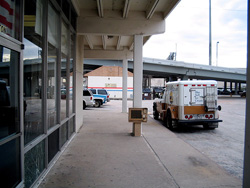 They say “If you build it, they will come,” but High Speed Rail is not a movie. It’s a multi-billion dollar expense. As a traveler (and tourism educator), I want to love high speed rail, but it just doesn’t make sense in most of America.
They say “If you build it, they will come,” but High Speed Rail is not a movie. It’s a multi-billion dollar expense. As a traveler (and tourism educator), I want to love high speed rail, but it just doesn’t make sense in most of America.
There are no blinding statistics here, just basic logic. There are ways to some ways to shoot through these arguments, which I would happily rebut, but I wanted to make it simple.
1) The cost of high speed rail is too high when compared to possible usage. The most studied high-speed rail line is the Orlando-Tampa route.
The cost of this rail line will be $2.6 billion. The state of Florida (quoted by the Orlando Sentinel ) predicts 2.4 million riders a year. I’m not a firm believer in that number, but we need to start somewhere. Over the course of 30 years, that equates to 72 million riders. They would need to charge about $36 a ticket just to pay for the rail line. But that is only a fraction of the true cost. My ninth-grade math doesn’t give one dime to operations, maintenance, upkeep, staffing, marketing, or even interest payments. So what would they really need to charge to begin to break even? Who is going to spend $45, 55, 65 per person each way ($90-130 round trip) to shave less than an hour off a drive?
So, not only are we subsidizing the building of the rail system, we will need to subsidize the operation of it. Of course some politicians want to build it. Building a rail means short-term jobs. But wasted money is wasted money, whether it’s mine or yours.
2) There’s an option with no infrastructure. It’s called a bus: For some reason, “bus” is a dirty word. Very seldom in this great rail debate does the word bus appear. Taking a bus from Chicago to Champaign (Illinois) takes the same amount of time as the train, but there are 10 daily busses to choose from (and only 3 trains). In the Northeast, Megabus and Bolt Bus have proved there is demand for low-cost intercity busses. High speed rail will certainly shorten this journey, but is the 30 minute time difference worth an expenditure in the billions?
Those who perceive the bus as low-class should note that Argentina has developed a niche of luxury busses, some of which even have on-board meals and attendants.
3) It’s easier and cheaper to drive in most of the U.S.. Who wants to spend more for less convenience? Rail works in the Northeast corridor of the United States, like it works in much of Europe. (See the America 2020 report on where rail may work best) There are densely populated cities, where it is feasible to live and visit without a car due to public transportation like subways. There are large barriers to driving: very crowded freeways, high tolls, and expensive parking. For these reasons, I support high-speed rail in the Northeast Corridor.
Now let’s take the model to Ohio, where a high-speed train has been proposed from Columbus to Cincinnati. How will Columbusites get to the train station? The same way they get to the airport. Most will need to drive (which already requires a car). Once they end up in downtown Cincinnati, what will they do? Cincinnati is not New York City, where they can arrive at Grand Central and hop on a subway. They cannot walk to all of the attractions. Likely, the business meetings they will attend will not be by the train station.
How much does it cost to drive from Columbus to Cincinnati: just enough gas to go 100 miles and about two hours of time. You can leave whenever you want, and you can go anywhere in the Metro area you want just by hopping behind the wheel.
How many people will pay a premium to get Cleveland to Columbus in 1 ½ hours instead of 2? I don’t know very many.
The train makes sense for those people with no driver’s licenses, but that’s a target market I’m not willing to invest in. This isn’t Europe, where driving is difficult, renting cars is expensive, crossing borders is difficult, and signs are in different languages. This is America, with multi-lane freeways, truck stops, and parking garages.
4) I arrived by train. Now what? You have just taken the train from Orlando to downtown Tampa. Now what? You need to get a cab to the beach or Busch Gardens. Or you need to rent a car. But you could’ve just rented a car in Orlando, driven to Tampa and saved the train fare.
Four round trip tickets on the train (let’s conservatively say $25 per person each way, even though that is below a break-even). A family of four would spend $200 for round trip tickets. Plus, they will need to add cab fare all around the metro area. From Orlando, they could rent a car for four days and buy gas for much less, and they would not be subject to train schedules.
The same situation applies in the Houston-Dallas route proposed by America 2050. You arrive in downtown Houston, but the train station is not on the light rail line. So it’s on a city bus or in a taxi.
I want to love high-speed rail. But America is not Europe. And remember that “successful deployment” of high-speed rail in Europe does not mean it pays for itself without government subsidies.
I want to spend money to encourage travel. I have spent my adult life encouraging the virtues of travel. I want to get people off the roads. But building a billion-dollar high-speed rail in ill-advised corridors doesn’t cure our problems unless we want endless subsidies. Amtrak already loses money. And, by listening to the news from Congress (and every state legislature), we only want subsidies if someone else is willing to pay for it. Surely there is another legacy we can leave the future.
Let’s focus our high-speed rail efforts on the Northeast, where it really works, and where it is necessary. Let’s pull the plug on the rest and stop dreaming of the whistling trains leaving from winter stations.
-
New York Times “How Flaws Undid Obama’s Hope for High-Speed Rail in Florida”
- Global Postmark, “Romance of the Rails?”
Photo Credits: Houston Train Station: mrbill (http://www.flickr.com/photos/mrbill/247019502/sizes/m/in/set-72157594290292220/); Inside car: Prayitno (http://www.flickr.com/photos/34128007@N04/4662620544/sizes/m/in/photostream/

